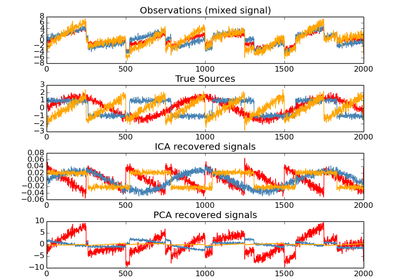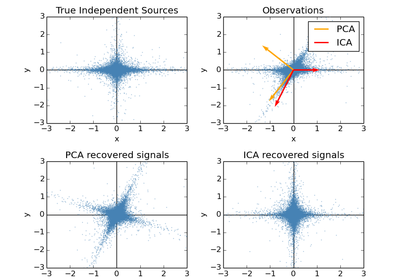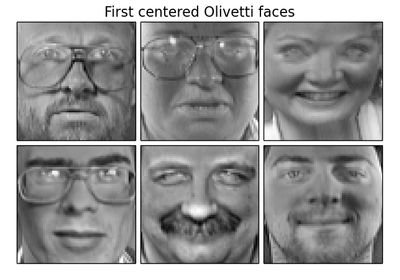sklearn.decomposition.FastICA¶
- class sklearn.decomposition.FastICA(n_components=None, algorithm='parallel', whiten=True, fun='logcosh', fun_args=None, max_iter=200, tol=0.0001, w_init=None, random_state=None)¶
FastICA: a fast algorithm for Independent Component Analysis.
Parameters: n_components : int, optional
Number of components to use. If none is passed, all are used.
algorithm : {‘parallel’, ‘deflation’}
Apply parallel or deflational algorithm for FastICA.
whiten : boolean, optional
If whiten is false, the data is already considered to be whitened, and no whitening is performed.
fun : string or function, optional. Default: ‘logcosh’
The functional form of the G function used in the approximation to neg-entropy. Could be either ‘logcosh’, ‘exp’, or ‘cube’. You can also provide your own function. It should return a tuple containing the value of the function, and of its derivative, in the point. Example:
- def my_g(x):
return x ** 3, 3 * x ** 2
fun_args : dictionary, optional
Arguments to send to the functional form. If empty and if fun=’logcosh’, fun_args will take value {‘alpha’ : 1.0}.
max_iter : int, optional
Maximum number of iterations during fit.
tol : float, optional
Tolerance on update at each iteration.
w_init : None of an (n_components, n_components) ndarray
The mixing matrix to be used to initialize the algorithm.
random_state : int or RandomState
Pseudo number generator state used for random sampling.
Attributes: `components_` : 2D array, shape (n_components, n_features)
The unmixing matrix.
`mixing_` : array, shape (n_features, n_components)
The mixing matrix.
`sources_` : 2D array, shape (n_samples, n_components)
The estimated latent sources of the data. This attribute is deprecated and will be removed in 0.16. Use fit_transform instead and store the result.
Notes
Implementation based on A. Hyvarinen and E. Oja, Independent Component Analysis: Algorithms and Applications, Neural Networks, 13(4-5), 2000, pp. 411-430
Methods
fit(X[, y]) Fit the model to X. fit_transform(X[, y]) Fit the model and recover the sources from X. get_mixing_matrix(*args, **kwargs) DEPRECATED: To be removed in 0.16. get_params([deep]) Get parameters for this estimator. inverse_transform(X[, copy]) Transform the sources back to the mixed data (apply mixing matrix). set_params(**params) Set the parameters of this estimator. transform(X[, y, copy]) Recover the sources from X (apply the unmixing matrix). - __init__(n_components=None, algorithm='parallel', whiten=True, fun='logcosh', fun_args=None, max_iter=200, tol=0.0001, w_init=None, random_state=None)¶
- fit(X, y=None)¶
Fit the model to X.
Parameters: X : array-like, shape (n_samples, n_features)
Training data, where n_samples is the number of samples and n_features is the number of features.
Returns: self :
- fit_transform(X, y=None)¶
Fit the model and recover the sources from X.
Parameters: X : array-like, shape (n_samples, n_features)
Training data, where n_samples is the number of samples and n_features is the number of features.
Returns: X_new : array-like, shape (n_samples, n_components)
- get_mixing_matrix(*args, **kwargs)¶
DEPRECATED: To be removed in 0.16. Use the mixing_ attribute.
Compute the mixing matrix.
Returns: mixing_matrix : array, shape (n_features, n_components)
- get_params(deep=True)¶
Get parameters for this estimator.
Parameters: deep: boolean, optional :
If True, will return the parameters for this estimator and contained subobjects that are estimators.
Returns: params : mapping of string to any
Parameter names mapped to their values.
- inverse_transform(X, copy=True)¶
Transform the sources back to the mixed data (apply mixing matrix).
Parameters: X : array-like, shape (n_samples, n_components)
Sources, where n_samples is the number of samples and n_components is the number of components.
copy : bool (optional)
If False, data passed to fit are overwritten. Defaults to True.
Returns: X_new : array-like, shape (n_samples, n_features)
- set_params(**params)¶
Set the parameters of this estimator.
The method works on simple estimators as well as on nested objects (such as pipelines). The former have parameters of the form <component>__<parameter> so that it’s possible to update each component of a nested object.
Returns: self :
- sources_¶
DEPRECATED: To be removed in 0.16. Use fit_transform and store the output instead.
- transform(X, y=None, copy=True)¶
Recover the sources from X (apply the unmixing matrix).
Parameters: X : array-like, shape (n_samples, n_features)
Data to transform, where n_samples is the number of samples and n_features is the number of features.
copy : bool (optional)
If False, data passed to fit are overwritten. Defaults to True.
Returns: X_new : array-like, shape (n_samples, n_components)




